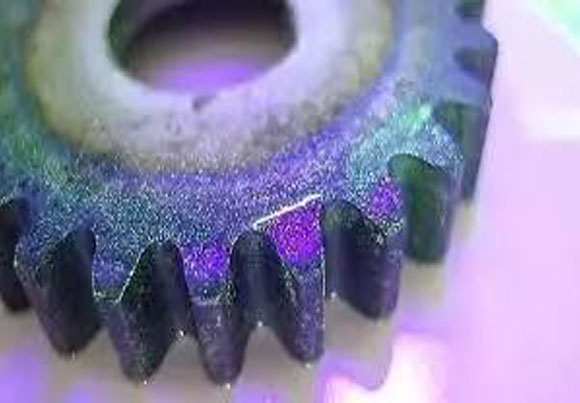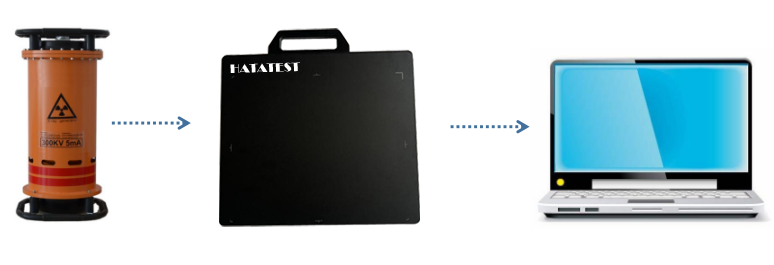In the magnetic particle inspection on the surface of the rough workpiece, in order to make the color of the defect magnetic trace and the surface color of the workpiece have a high contrast, in order to facilitate the discovery of the defect display, before the detection, a white coating film is generally sprayed on the surface of the workpiece, and dried. The workpiece is then magnetized and a magnetic suspension is applied to form a clearly visible magnetic trace display. The white coating film applied is a contrast enhancer.
Both the magnetic particle testing specification and the testing process stipulate that the water breaking (wetting performance) test and the standard test piece system sensitivity verification are required, and the timing of selecting the contrast enhancer is particularly important, which may affect the detection result.

1. water break (wetting performance) test
The water break (wetting property) test is a test in which a hydromagnetic suspension is applied to the surface of a workpiece to observe the wettability of the hydromagnetic suspension before the magnetic powder is detected. The test is carried out after stopping the pouring of the magnetic suspension. If the hydromagnetic suspension film on the surface of the workpiece is continuous, it is connected to the entire surface of the workpiece, indicating that the wetting property is good; if the hydromagnetic suspension film on the surface of the workpiece is broken, The workpiece has a bare surface, indicating that the wettability of the hydromagnetic suspension is unacceptable.
This brings about the problem of the timing of the implementation of the water break test, that is, the water break test is first carried out and then the contrast enhancer is applied. Or do you apply a contrast enhancer before performing a water break test? The impact of different water break test implementation timing on the test results also needs to be analyzed.
The purpose of the water break (wetting performance) test is to test the surface pretreatment effect of the workpiece and verify that the magnetic suspension wets the surface of the workpiece well.
If the water cut (wetting performance) test is performed after applying the contrast enhancer, there are two disadvantages:
First, if the operation is improper (such as the contrast enhancer after application is not dry enough, the pressure is too large, etc.), the water-off (wetting property) test may rush off the white coating film, and the effect of enhancing contrast is not obtained;
Second, the surface is covered by a coating film, and the surface pretreatment effect of the workpiece often fails to meet the requirements of testing.
Conversely, if the contrast enhancer is applied after the water break (wetting performance) test, the benefits are obvious:
First, it can correctly reflect the wetting effect of the surface of the workpiece after pretreatment. Secondly, the magnetized spray (casting) magnetic suspension is applied to the workpiece after the contrast enhancer is applied, which can form a magnetic trace display with high contrast and improve the detection sensitivity. .
During the operation, it should be noted that the water break (wetting property) should be dried after drying (natural drying or hair dryer drying), and then the contrast enhancer is applied, otherwise the contrast enhancer cannot be used with the workpiece surface. Very good fit.
2. Standard test system sensitivity verification
The application of contrast enhancers can also interfere with the sensitivity verification of standard test strips. The standard test piece system sensitivity verification refers to the comprehensive performance of the magnetic particle testing equipment, magnetic powder and magnetic suspension before and after the start of magnetic particle testing, the approximate magnetic field strength, direction, effective magnetization area and detection process of the workpiece surface. The procedure for verifying whether the operation is properly performed.
It can be seen that the standard test piece needs to be processed under the same test conditions as the workpiece, and the display result is representative. Therefore, the link of the standard test piece should be completed at the end of the water break (wetting performance) test, after the surface of the workpiece is dried, and the contrast enhancer is applied simultaneously with the workpiece, and then the magnetized and applied magnetic suspension is applied to the workpiece under the same detection process. Observe the shape of the magnetic trace displayed on the sensitivity test piece to determine the correctness of the detection process (sensitivity verification).
In summary, for the case where the surface of the workpiece is rough or the contrast between the color of the workpiece and the color of the magnetic powder is low, the non-fluorescent magnetic powder, wet and continuous magnetic powder detection, the process flow is shown in Figure 1:

Figure 1 Magnetic particle testing process
In the magnetic particle testing process, the timing of the contrast enhancement agent application, the water break (wetting performance) test and the sensitivity test of the standard test piece system can be controlled to obtain the correct test result.
-
 Sales@hata-ndt.com
Sales@hata-ndt.com -
 +86 371 63217179
+86 371 63217179










